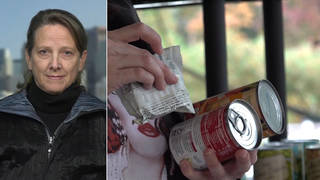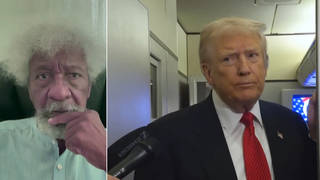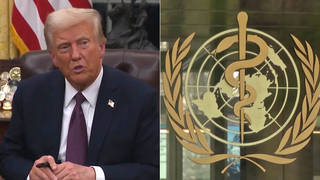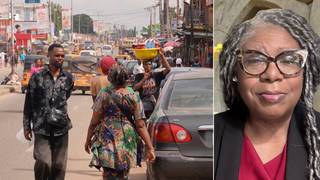
Topics
Guests
- Monica Gandhiinfectious disease specialist, professor of medicine at the University of California, San Francisco, and a division head at San Francisco General Hospital.
While COVID-19 infection rates and hospitalizations appear to be waning, the United States has a long way to go before people can safely return to everyday life without masks. Dr. Monica Gandhi, an infectious disease physician and professor of medicine at the University of California, San Francisco, says it’s vital to stay vigilant even as vaccinations ramp up. “If we can get our transmission down as low as possible, that is actually going to make the vaccines more effective.”
Transcript
AMY GOODMAN: This is Democracy Now!, democracynow.org, The Quarantine Report. I’m Amy Goodman, with Nermeen Shaikh.
While COVID-19 infection rates and hospitalizations appear to be waning, the United States has a long way to go before it can safely return to a maskless normal. The U.S. Centers for Disease Control chief, Dr. Rochelle Walensky, has said it’s absolutely too soon to lift mask mandates, citing daily COVID-19 case numbers that remain at more than double the levels seen last summer. She urged people to wear a more tightly fitted surgical mask or layer a cloth mask on top of a surgical mask.
DR. ROCHELLE WALENSKY: The bottom line is this: Masks work, and they work best when they have a good fit and are worn correctly.
AMY GOODMAN: Yes, we are far away from this pandemic being over, especially with the surge of variants.
For more on which masks to wear, how many, and also a brief discussion about vaccines, we’re joined by Dr. Monica Gandhi, infectious disease physician, professor of medicine at University of California, San Francisco, UCSF, and San Francisco General Hospital. She recently wrote a piece in the journal Med by Cell Press about how to wear face masks and is also studying the relationship between masks, distancing and ventilation.
Dr. Gandhi, welcome back to Democracy Now! As we talk about vaccines — and the lack of access to vaccines is a whole other story in this country, not to mention the rest of the world — but it seems like people are relaxing around wearing masks. Can you talk about how critical it is right now?
DR. MONICA GANDHI: Yes. So, it is an important time to wear masks. Why? Because if we can get our transmission down as low as possible, that is actually going to make the vaccines more effective. This is because a virus can’t mutate if it can’t replicate. And also, we’ve never rolled out a vaccine in any pandemic ever in the midst of a pandemic. Usually vaccines are made after. So the lower the transmission we can get in a community, the better the vaccine is going to be for efficacy.
NERMEEN SHAIKH: And, Dr. Gandhi, as far as masking is concerned, some former Biden advisers have urged a wider use of N95 masks, saying that CDC guidelines don’t go far enough. Your response? Is that correct?
DR. MONICA GANDHI: You know, actually, I think that they’re both right. And what I mean by that is it is time to increase what’s called the fit and filtration of our masks, but that there’s many ways to achieve that goal, and N95 is just one of them.
And what the CDC ended up doing is giving alternatives to that, because N95s, though they’re very fit, they have great filtration, they block out truly 95% of virus; they’re uncomfortable, they’re harder to get, and they actually have to be fitted. And so, what our study and the CDC study was doing, they were both actually trying to attempt to say what else could you wear besides an N95 that blocked out virus to the same degree.
And so, the CDC, just on February 9th, published an article in the MMWR that says, “OK, are there other ways to increase the fit and filtration of our masks?” And one way was putting this surgical and cloth mask together. Why? Because they filter in different ways. The surgical mask blocks electrostatically the virus; the cotton mask blocks it just through their fibers. And putting that together blocks as well as an N95. And there are other alternatives to that strategy, as well. So they’re sort of both right.
NERMEEN SHAIKH: Dr. Gandhi, can you talk, very quickly, about how you think masks should be worn?
DR. MONICA GANDHI: So, it really actually depends on which setting you’re in. And this is what’s important. We have never done a very good job in this country about tiered messaging — if x, then y. But we have a paper coming out tomorrow in Lancet Infectious Diseases, where we propose this nonpharmaceutical interventional triangle. And what that means is there’s masks on one side of the triangle, distancing on the other side, and ventilation on the third side. And if one goes up, the other can go down. So, if you’re outside, no reason to wear a stronger mask. You’re outside; you have ventilation going for you. If you’re inside and if you’re an adult, because the middle of the triangle is host susceptibility to COVID-19 — and if you’re an adult, you want to increase your — while we’re in this period still of decreasing transmission but still ongoing transmission, you want to increase the fit and filtration of your mask.
And there are two ways to do that, actually, the easiest ways to do that. One is an N95. The second is this surgical plus cotton together. You can layer it in whatever way you want. Since you just talked about Texas and the environment, I actually recommend the surgical mask on top of the cotton mask because you can use then the surgical mask multiple times.
And the third way is to put — take a cotton mask, and you can buy many of these on the internet, and it has a place for a filter inside. The two pieces of cloth with a filter inside block viral particles more effectively, because the filter blocks it one way, the cotton blocks it another way. And it’s actually quite a lightweight option to stick that filter inside, take it out when you’re washing it, and replace it after you’ve washed the mask.
AMY GOODMAN: And what are the most common mistakes in how people wear a mask? I mean, a critical point, I think, if they’re wearing, for example, a KN95 mask and a surgical mask on top of it, is not to wear that surgical mask, the paper mask, inside, but on the outside, because you’ll break whatever seal there is. Is that right?
DR. MONICA GANDHI: That is true, actually. So, a KN95 is actually really quite effective. And if you get it from a reputable company, genuinely, you don’t need any other layer, because it really does block the 95% of the virus. But if you’re going to put a layer on top of it, it is that seal around the face that is advantageous about KN95, and so anything you’re putting on with it, you want to put on top. That’s accurate. But, really, to make it super simple, KN95 or N95, two masks together, but it has to be these two separate ones, or the filter inside two cotton layers.
NERMEEN SHAIKH: Dr. Gandhi, I want to ask about the question of transmission, which is, of course, crucial for this question of masks — that is, transmission after vaccination. Since December 14th, when vaccinations began in the U.S., the U.S. has administered 55 million doses and is presently administering 1.8 million a day, which is the highest number in the world. You said recently — you quoted a doctor saying that it takes a special kind of pessimism to think that vaccines will not decrease transmission. Could you talk about that? What do we know about transmission of the virus after receiving two doses of the vaccination? And even if vaccination does decrease transmission, does it do away with it altogether?
DR. MONICA GANDHI: This is a great question. So, you know, the reason this is even a debate is because the trials were designed in a way that they were evaluating symptomatic COVID-19. If you didn’t feel well, you got swabbed. They said, “Uh-oh, you don’t have COVID in the vaccine trial, and you do have it in the placebo arm.” But it didn’t mean that we never thought it would decrease transmission. And there is increasing data that these vaccines, afterwards, will reduce or eliminate asymptomatic carriage in your nose so that you can’t pass it on.
Four biological reasons why we’d ever think that to happen. One is that the antibodies that the virus generates still get in your nose to clear viral carriage. They also produce another type of immunoglobulin called IgA, that gets in your nose. Third is that even those monoclonal antibodies that we give for treatment in outpatient therapy, they reduce viral carriage in your nose. And then, fourth is that in the macaque or primate models, when you gave someone the vaccine, it cleared it from the nose and the lower respiratory tract.
We now see increasing data from the Israel and the U.K., where rollout, both, are going actually extremely well. The cases are going down along with hospitalizations. They all block severe disease, but they also are blocking cases. And then, swabbing of the nose of people after vaccination, the viral load is going down by fourfold. So it’s very likely, and almost definitive, that it’s going to block transmission.
However, at this moment, until we know this, like, ironclad way, meaning we swab multiple people after their doses of vaccine — which is happening in the Pfizer and the Moderna vaccine participants — and ensure there’s no virus in the nose afterwards, we’re recommending that the vaccinated — two vaccinated people can be around each other without that mask and distancing. But we’re in a half situation, where some of us are vaccinated, some of us are not. And so the vaccinated are still asked to wear masks and distance in public, while we’re waiting for the unvaccinated to become vaccinated. At a certain point — and I reassure the public — these masks will go away, but we’re not quite there yet, until we get to herd immunity.
AMY GOODMAN: And can you talk about the variants — I mean, right now the South African and British variant so serious in the United States — and the race between getting the vaccine in time for dealing with these variants? Now with the storm in the South right now, we’re in a very stormy New York, snowstorm in New York. But certainly in Texas, in the South, that has really broken the supply chain, getting the distribution of vaccines, so hundreds of thousands of appointments, it sounds like, around the country are being canceled right now, because they can’t get the vaccine. What about that race? Why is the variant so critical here?
DR. MONICA GANDHI: You know, it’s true that this virus is going to mutate. It always has mutated. It doesn’t actually mutate that fast. It’s just that we’ve had so much transmission right now that these spike protein mutations are coming out.
There’s two — one reassuring, one unreassuring. Reassuring thing is that even against the variants, all the vaccines block severe disease. And I mean the Johnson & Johnson study was examining in the setting of the B1351, or the South Africa variant. Ninety-five percent of those strains in South Africa were of that variant. And Johnson & Johnson blocked completely hospitalizations and almost completely all severe disease, even if you’re out of the hospital. Good sign. That’s because T cells from our vaccines will block all severe disease.
But when you’re in a setting of replication, the variants can keep on going. There can be more mutations. And so it is a race. There is absolutely a race between getting everyone vaccinated and tamping down transmission. And so, the more critical — the faster we do this, it’s the most — it’s incredibly critical. And we’re in a complete race. And all of these — any blockage to vaccine distribution, like what you just mentioned in Texas and elsewhere, is a problem. But we’re going to get there. But it makes the race more urgent.
AMY GOODMAN: Well, we want to thank you so much for being with us, Dr. Monica Gandhi, infectious disease physician, professor of medicine at UCSF, San Francisco General Hospital.
Next, we look at mounting pressure for President Biden to cancel student debt. Stay with us.












Media Options